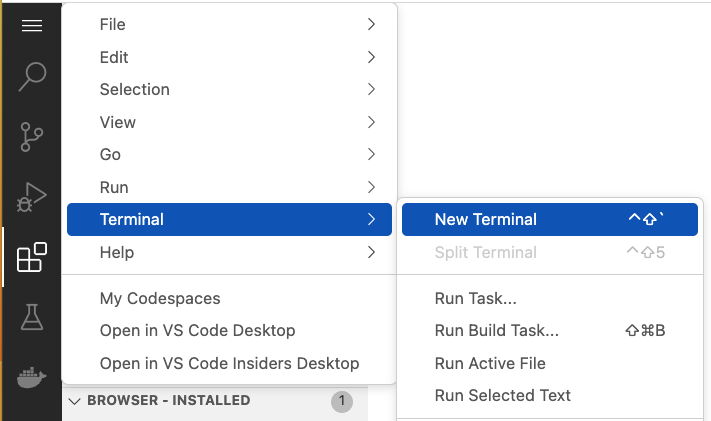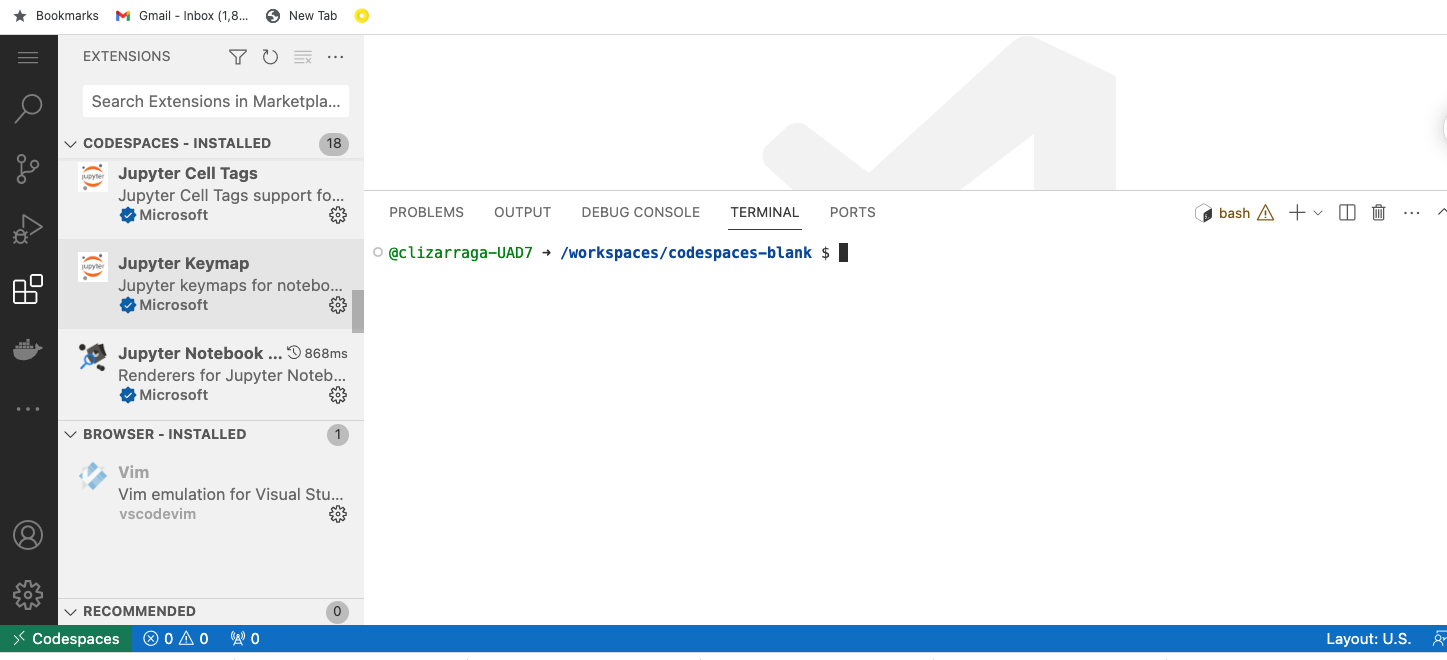Unix Shell and Unix Filesystem¶
Unix and Unix-like operating systems¶
For clarity, Unix is a family of multitasking, multi-user computer operating system. There is a large family of Unix-like operating systems.
Some well-known cases of Unix-like operating systems are Linux and BSD.
Sessions in UNIX/Linux¶
To work in a terminal, we need to have a valid username, in order to begin a session via the login command.
If using VSCode we can launch a new terminal from the "Hamburguer Menu" as shown in the next figure

The new terminal will open in the lower right part of the VSCode interface.

The terminal is ready for user input.
:memo: To end the session enter the exit command. It will finish the session and close the terminal.
The Command Shell or Command Line Interpreter¶
In the background a Command shell is running. To find out which shell is active we can type the following command after the system prompt $.
which will return the command shell program, /bin/bash, in the Codespaces terminal. This is Bash (Bourne Again Shell), which is derived from the original shell /bin/sh. In other system environments, maybe you will encounter other similar shells (/bin/csh, /bin/tcsh, /bin/ksh, /bin/zsh, and others).
The command shell serves as an intermediary between the user and the Operating System Kernel, which controls all the available computer resources.

Read more on the Unix Shell¶
Files and Directories¶
The Unix filesystem is considered as the central component of the operating system. The filesystem provides storage and retrieval for other programs to read them. The filesystem also provides access to other resources, for example the device files, terminals, printers, computer mice, and many other.
| Directory or file | Description |
|---|---|
/ |
The root directory is the top-level directory in the Unix file system. |
/bin |
The bin directory contains executable programs. |
/dev |
The dev directory contains device files. |
/lib |
The lib directory contains libraries. |
man |
The man directory contains manual pages. |
/etc |
The etc directory contains configuration files. |
/home |
The home directory is the default directory for each user. |
/tmp |
The tmp directory is a temporary directory where files can be created and deleted without affecting the rest of the file system. |
/usr |
The usr directory contains system files that are shared by all users. |
/var |
The var directory contains files that can vary in size, such as log files and mail files. |
The Unix file system is a hierarchical structure, with each directory containing a set of files and subdirectories. The root directory is the top-level directory, and all other directories are below it.

First steps: Manual pages and getting help¶
In general, almost all Unix systems include their manual pages of system commands.
| Commands | Description |
|---|---|
man command |
Online manual pages |
apropos keyword |
Searches keyword in manual pages |
command --help |
Show how to use command |
more filename |
Show contents of a text file |
less filename |
Show content of a text file |
The more and less commands show the contents of a file. The following commands control the flow of information.
| Command | Action in less / more |
|---|---|
d or Space bar |
page down |
u |
page up (less) |
p |
beginning of file |
G |
End of file |
q |
Quit and exit |
ls: Listing files in directories¶
The ls command, lists all the contents of a directory.
For example ls -al will list all files in a directory in long format, including hidden files (those files whose name starts with a dot .)
Try ls --help to show you all the available options of the command.
The command ls -al */* shows all the contents of a directory and subdirectories next level down.
pwd: Prints present/working directory¶
The pwd command, will show the current position in the directory structure.
cd: Change the working directory¶
The cd command, will help you navigate in the directory structure.
Common commands
| Command | Action |
|---|---|
cd |
A blank option takes you to your HOME directory |
cd ~ |
Same as above, takes you to your HOME directory (where ~ is aka tilde) |
cd .. |
Moves you up, to the parent directory |
cd ../.. |
Moves you up two levels |
cd - |
Moves you to the previous working directory |
See more Unix Shell Commands here¶
References¶
- The Command Line Interface Shell
- Introducing the Shell
- Navigating Files and Directories
- explainshell.com
Created: 05/13/2023: Updated: 05/15/2023
Carlos Lizárraga